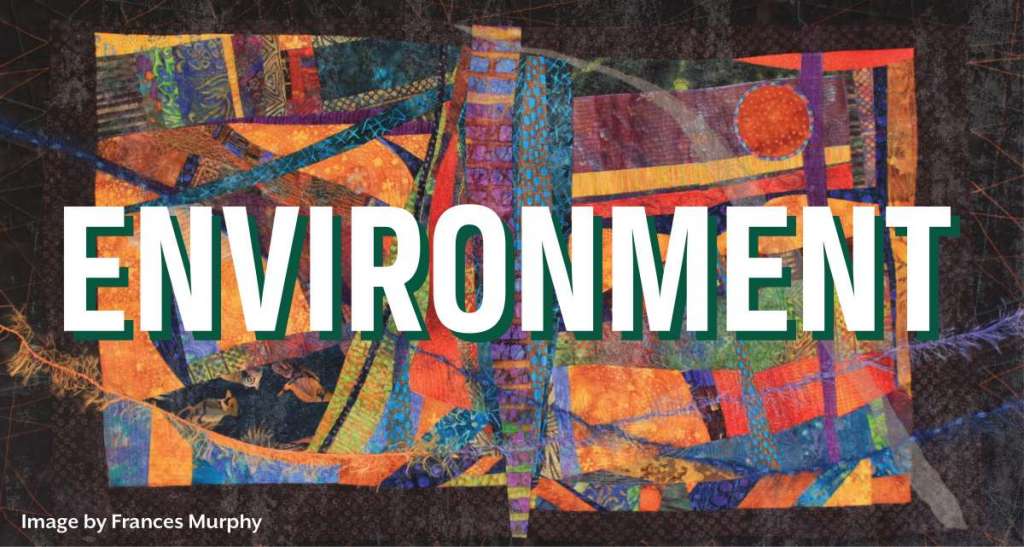There once was a daisy that grew on a desert plain,
Where the sun helped it grow and so did the rain –
Links in a food chain.
There once was a grasshopper who nibbled on flowers,
Nibbled on flowers for hours and hours!
The bug ate the daisy that grew on the desert plain,
Where the sun helped it grow and so did the rain –
Links in food chain.
There once was a cactus wren who gobbled up bugs,
And creepies and crawlies and slimies and slugs.
The wren ate the bug who nibbled on flowers,
Nibbled on flowers for hours and hours!
The bug ate the daisy that grew on the desert plain,
Where the sun helped it grow and so did the rain –
Links in a food chain.
There once was a snake who often grabbed birds,
And swallowed them whole, or so I have heard.
The snake ate the wren who gobbled up bugs,
And creepies and crawlies and slimies and slugs.
The wren at the bug who nibbled on flowers,
Nibbled on flowers for hours and hours!

The bug ate the daisy that grew on the desert plain,
Where the sun helped it grow and so did the rain –
Links in a food chain.
There once was a coyote, and I’ll make a bet,
He’d eat anything he could possibly get.
The coyote ate the snake who often grabbed birds,
And swallowed them whole, or so I have heard.
The snake are the wren who gobbled up bugs,
And creepies and crawlies and slimies and slugs.
The wren ate the bug who nibbled on flowers,
Nibbled on flowers for hours and hours!
The bug ate the daisy who grew on the desert plain,
Where the sun helped it grow and so did the rain –
Links in a food chain.
The coyote grew older and died one spring day,
But he made the soil rich when he rotted away.
A new daisy grew where he died on the desert plain,
And the sun helped it grow and so did the rain –
Links in a food chain.
Day 1 – Who Eats Whom
What Is It?
Food Web: Concept and Applications
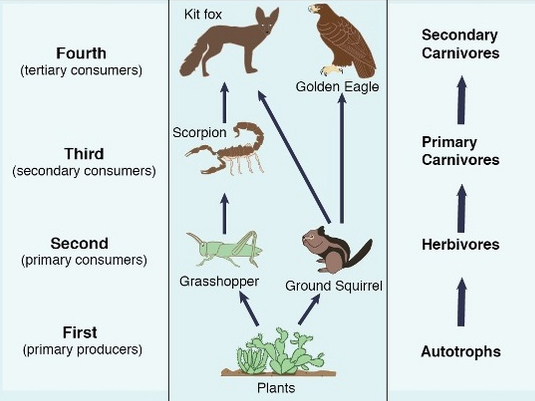
Food Chains In A Single Ecosystem
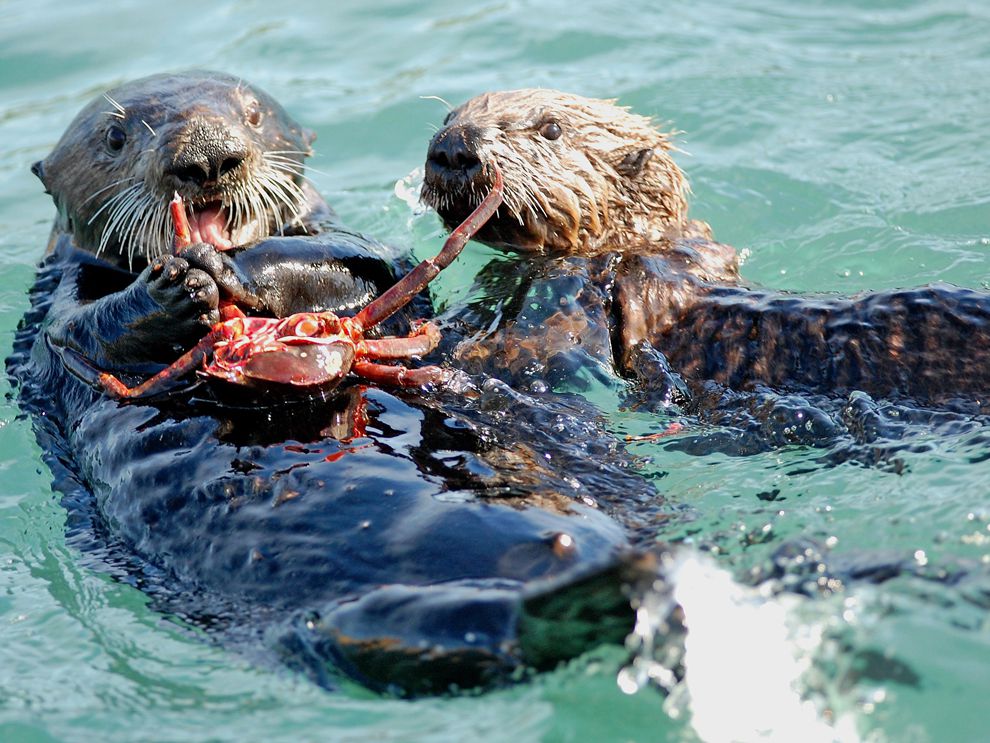
Food Chains
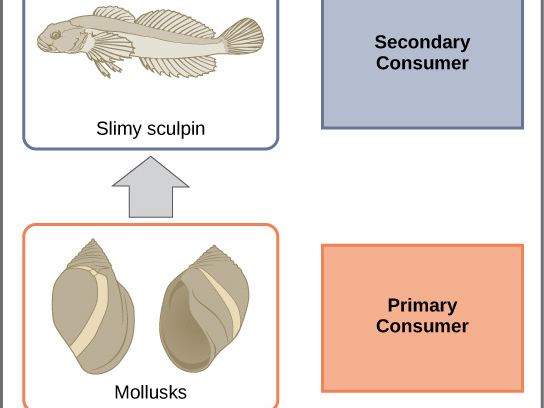
Life On the Food Chain

Videos
A Million Sharks
Food Chains for Kids
Fabulous Food Chains
[expand title=”MORE VIDEOS” rel=”fiction”]
Science Trek – Food Web
Food Chains & Food Webs
The Dirt on Decomposers
[/expand]
Day 2 – Activity Time
Food Chains and Food Webs
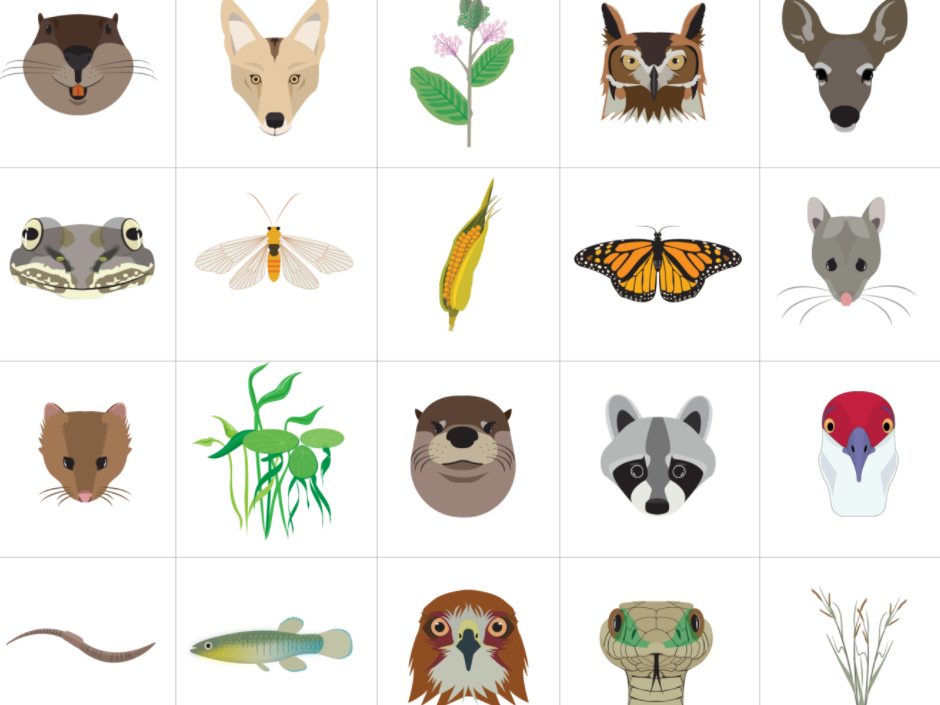
Weaving a Food Web
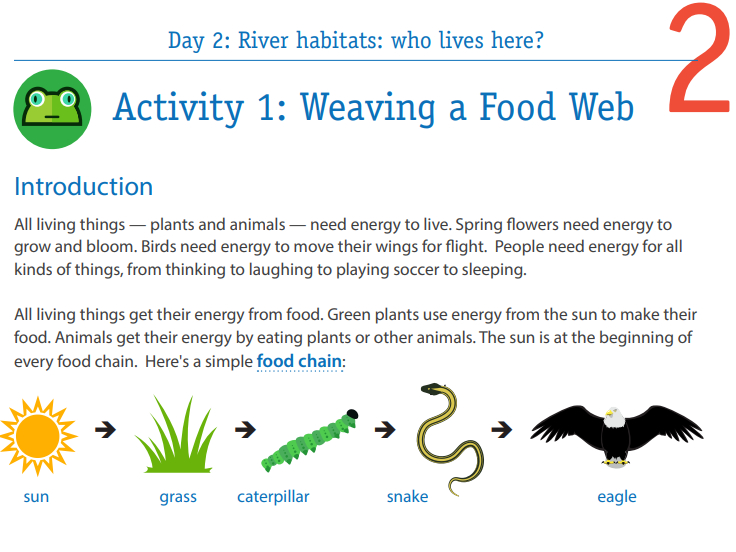
Got Energy? Food Web
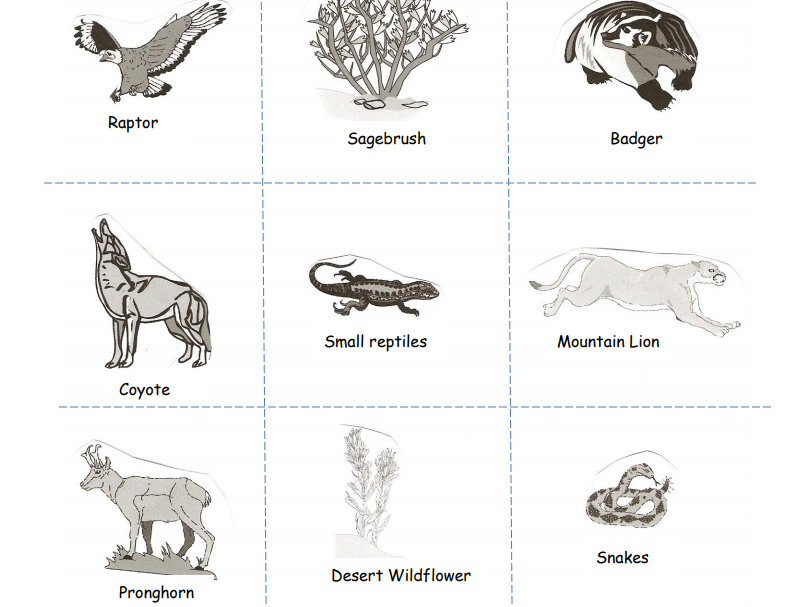
Weaving the Web
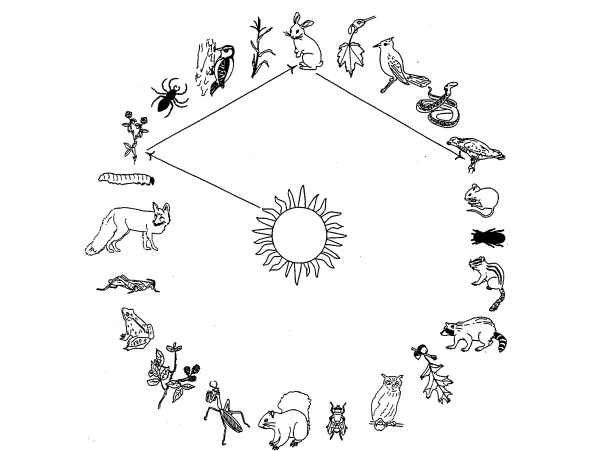
Desert Biome
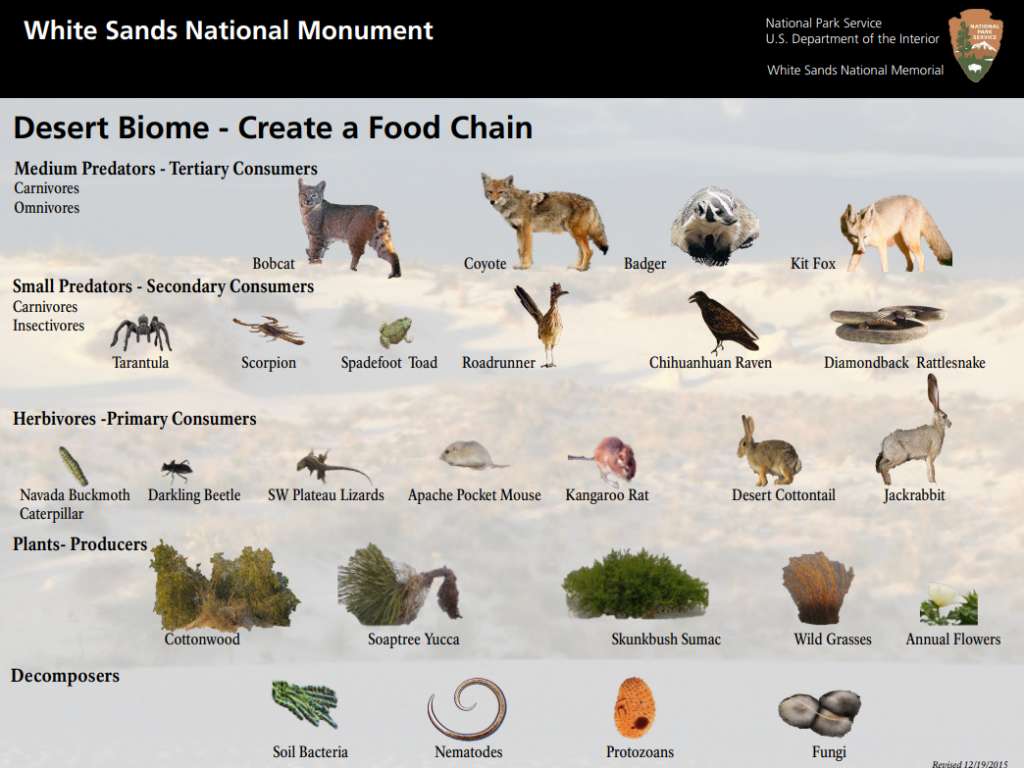
Paper Food Chains
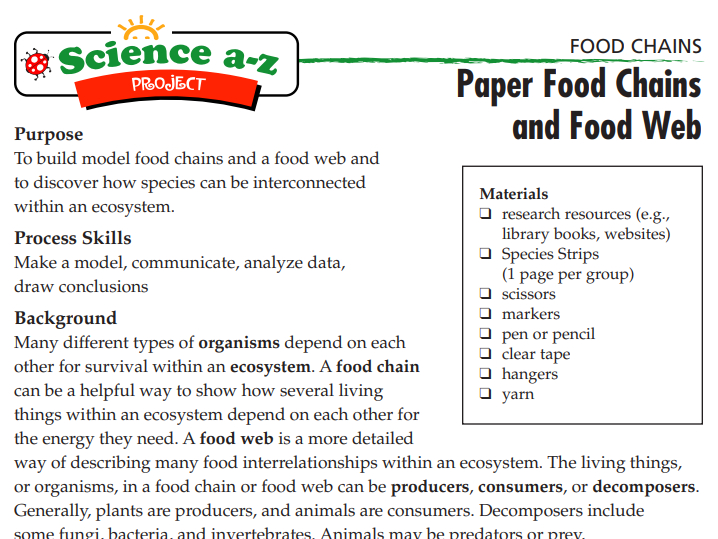
Day 3 – Artistic Expression
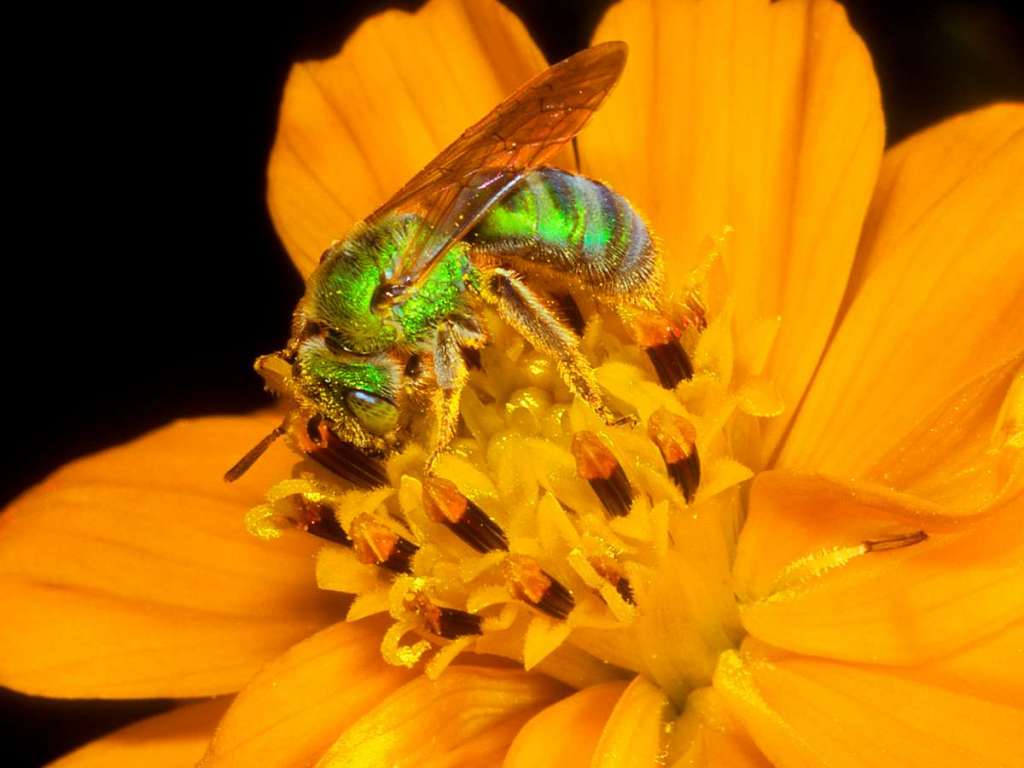
Download this week’s coloring sheets featuring the Food Chain
Get To Know The Artists
Annie Gordon
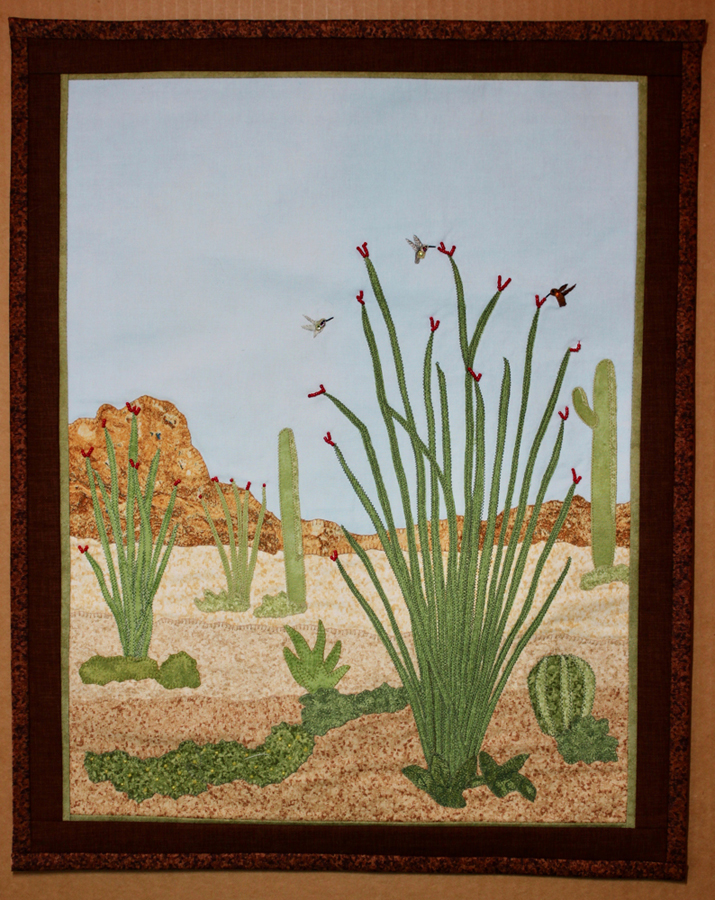
Abundance
“Hummingbirds are the main source of pollination for the ocotillo because they have the ability to delve deeply into the elongated flowers. In the
More
spring, the ocotillos bloom profusely just as hummingbirds are migrating and so our year round hummers are joined by many other varieties. While I know that all hummingbirds are very territorial about their food sources, in my interpretation, I have Anna’s, Costa’s and Rufous Hummingbirds all sharing in the abundance.”
“I remember being taught how to embroider by a friend’s grandmother when I was in 1st grade and love and use embroidery to this day. I am self-taught in many fabric related arts and have taken many classes through the years. In 1981, I earned an MFA in Weaving and Textile Design from the School for American Crafts at RIT in Rochester, NY. For many years, I wove and sold scarves, shawls and jackets.
I moved to Tucson in 1989, and though I no longer weave, I do continue to work with fabrics creating wall art, quilts, clothing and accessories.”
To view more pieces by Annie Gordon, go to https://www.etsy.com/shop/AnnieGFabricArt
Mark Thaler

Green Metallic
“The path to successful pollination are numerous and quite varied which opens up a rather amazing window of possibilities. Bees play a major role in transferring pollen and are quite fascinating to witness during energetic visits to an impressive variety of flowering
More
plants. This photograph was taken as a sweat bee (Family: Halictidae) found nectar and nourishment grazing the florets of a cosmos flower (Cosmos sulphureus ). Green metallic bees can shine with golden pollen grains gathered along the way.”
Mark Thaler is currently a Senior Staff Photographer with UAHS BioCommunications Dept. He came to the Southwest over 40 years ago to study anthropology, also photography and received a B.A. from the University of New Mexico in 1976.
Nancy Chilton
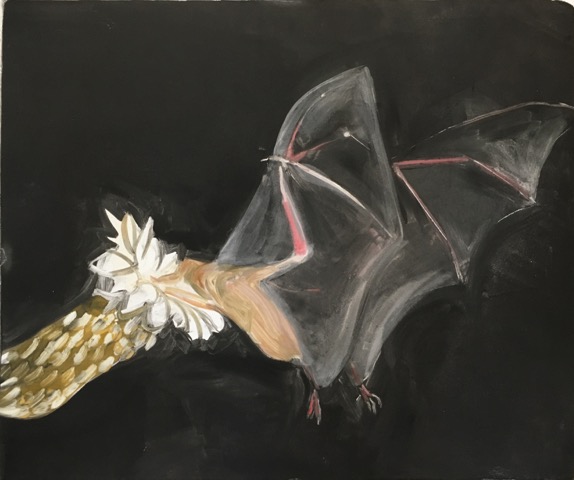
Nectar Buena
“This monotype was inspired in large part by Theodore H. Fleming’s No Species Is an Island, a study of the pollination biology of three species of columnar cacti at a site in Sonora, Mexico, near Kino Bay. What captivated
More
me in particular were the relationships between these cacti and the lesser long-nosed bats (Leptonycteris yerbabuenae), who feed on the nectar, pollen, and fruit of these and other desert plants (including legumes and agaves) during migration. I was not as familiar with this species as I was with its insect-eating relatives, and found myself smitten by these charming, graceful, and athletic bats.
Lesser long-nosed bats join other species of pollinators, including hummingbirds and insects, along routes that Fleming calls ‘nectar corridors’ – seasonal routes defined by a sequence of plants that bloom along a south-to-north gradient in the spring, then reverse in the fall.
Federally listed for protection in the U.S. and Mexico, lesser long-nosed bats are crucial players in a constellation of symbiotic interconnections. These interconnections allow unique and diverse ecosystems to evolve and flourish over long distances.”
Nancy received her BFA degree from the University of Arizona with an emphasis on figure drawing. She has been making art in Tucson since 1982. Nancy has shown and sold her artwork at galleries and other venues in Tucson, Phoenix, and elsewhere. As a Drawing Studio staff member and instructor, she loves to see individuals gain enthusiasm and confidence as artists.
To learn more about Nancy Chilton and her work, go to https://thedrawingstudiotds.org/meeting-teaching-artist-board-member-nancy-chilton/
Theodore Fleming
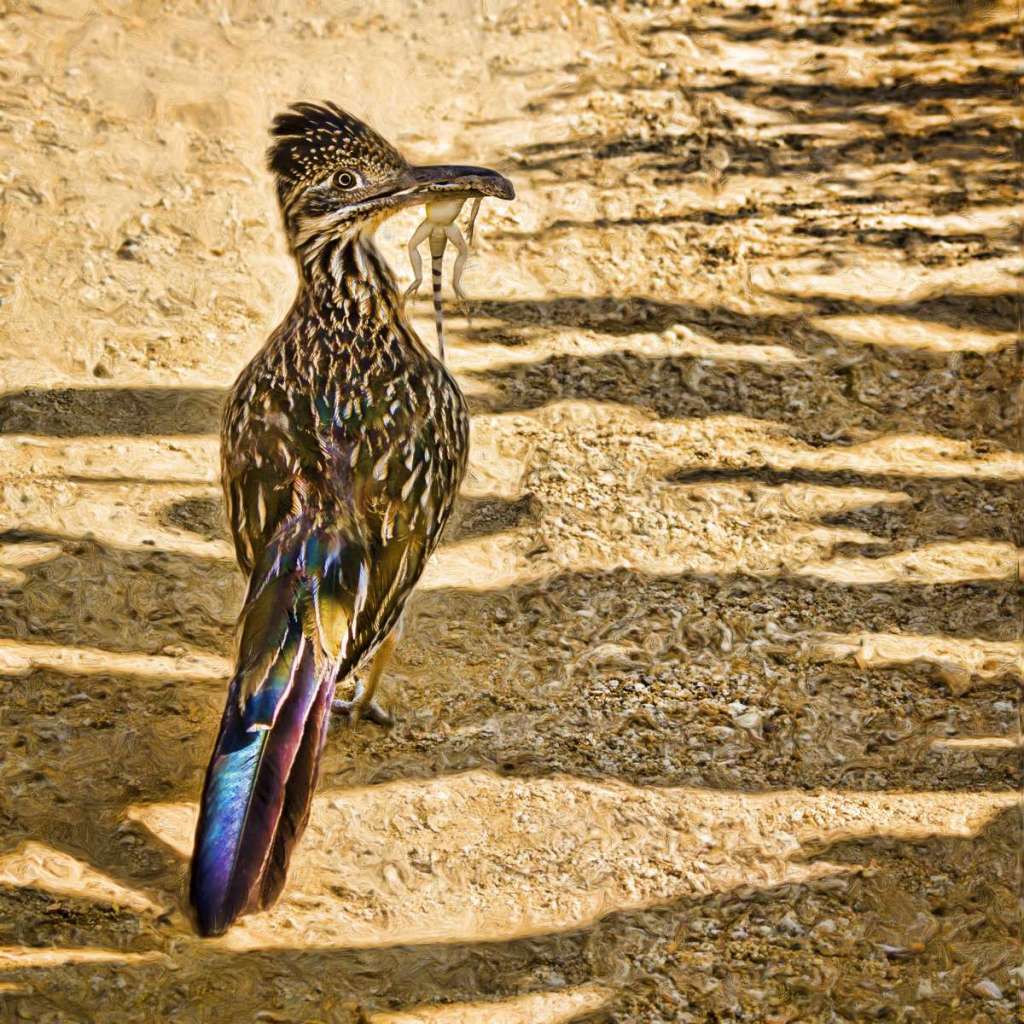
Circle of Life
“I took this photograph of a female Greater Roadrunner (Geococcyx californianus) with a Zebra-tailed Lizard in its mouth on the north desert trail at Tohono Chul. A pair of these birds’
More
nests in this area. Roadrunners are iconic birds of the Sonoran Desert and other arid habitats in the U.S. Southwest and northern Mexico. Members of the cuckoo family (Cuculidae), roadrunners are voracious predators and include lizards, snakes (including small rattlesnakes), baby and adult birds, and small mammals in their diet. They can fly but spend most of the time on the ground; they can run up to 20 miles per hour.”
“I am a tropical ecologist with a specialty in plant-animal interactions and a long-time amateur photographer. I have been able to travel extensively in the tropics in my research, always with camera in tow. But, I feel that my photography has really blossomed in the digital age and want to share my ‘vision’ with others. I am particularly interested in ‘painterly’ images and often convert my favorite photos into digital paintings under the influence of artists such as Monet, Renoir, Van Gogh, Edward Hopper, and Maynard Dixon. I have rather eclectic tastes in my subjects but have done little landscape photography. Given my background as a biologist, I particularly enjoy photographing wildlife, but I also like to photograph ‘people doing interesting things.’ Living and traveling in tropical countries has fueled my interest in diverse cultures.
As an artist, I am often drawn to images that are visually complex (reflecting my lifelong interest in biological diversity) and colorful. I also seek images that are elegant in composition or in their graphic elements. One of my current techniques involves creating photomontages as a way to emphasize the place of wildlife and people in their natural environments.”
To learn more about Ted and his work, visit https://www.tedflemingphotography.com/
Day 4 – Artistic Interpretation
Christopher Allison
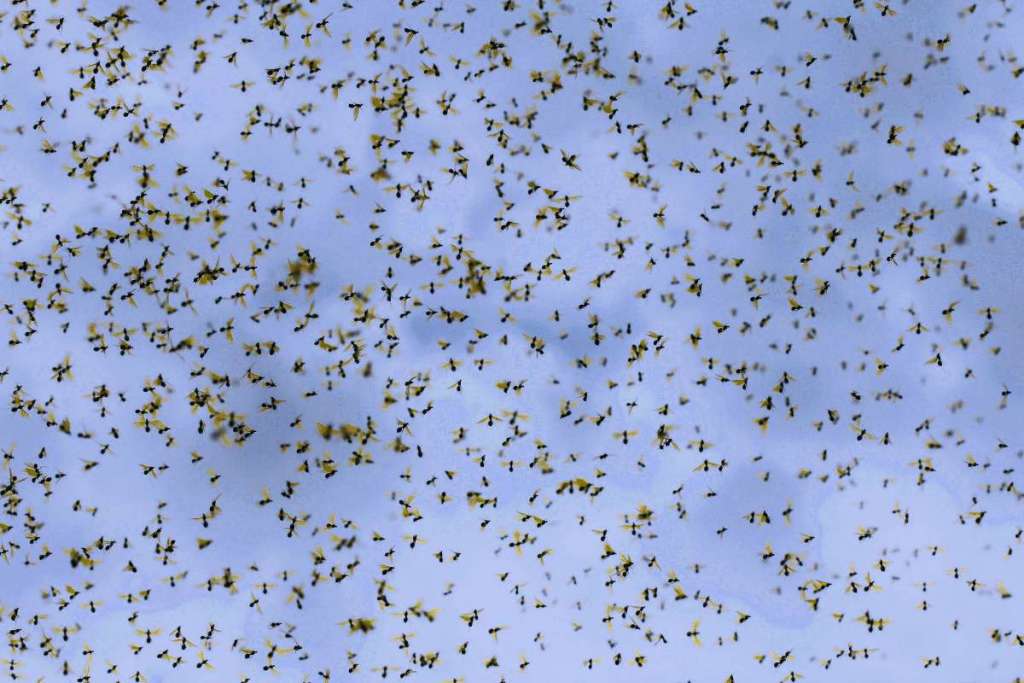
Leaf Cutter Ant Nuptial Flight
“The nuptial flight of the leaf cutter ant carries with it an ancient form of symbiosis. Leaf cutter ants collect leaves to create underground fungi
More
gardens. Unable to digest the leaves, the ants process them into food for the fungus. The fungus then feeds the entire colony. After a monsoon rain, winged male and female ants emerge and converge in mating swarms. Each queen carries a small amount of fungus with her to start a new colony.”
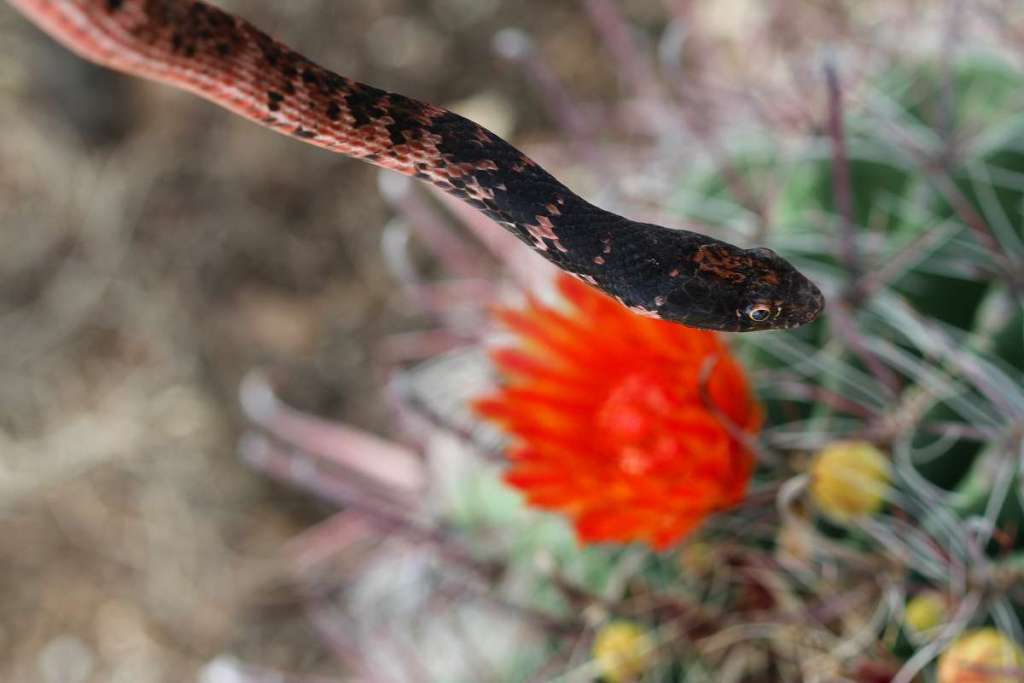
The Nurse Tree
“A coachwhip snake hangs from a branch in a mesquite tree which is serving as a nurse tree for this blooming barrel cactus. Nurse trees provide
More
shelter and create a microclimate that allows slower growing plants an opportunity to thrive. The coachwhip often uses these trees for shelter and to search for prey.”
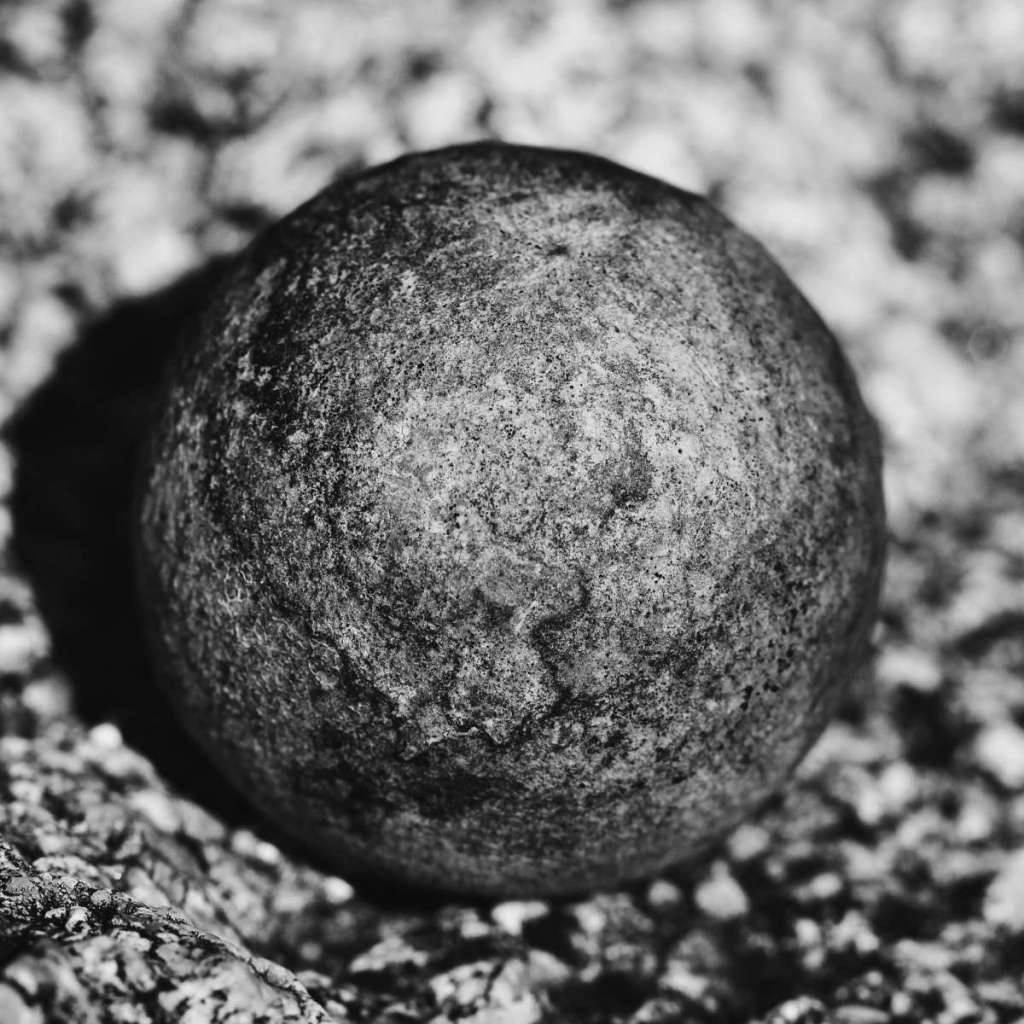
Mexican Blue Oak Wasp Gall
“The unusual growths seen on the leaves of Mexican Blue Oak trees are often the result of
More
gall wasps. These wasps lay their eggs in the leaves of the trees which respond by forming a cyst-like structure around the egg. When the larvae hatches it feeds on the gall.”
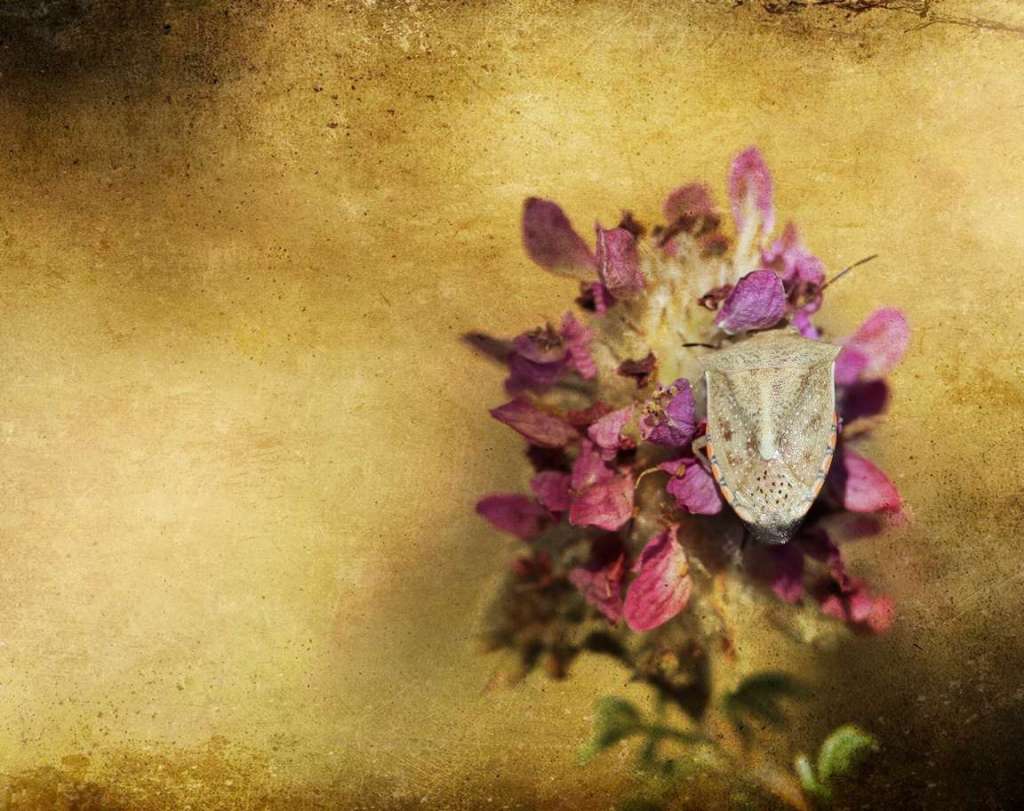
The Shielded Pollinator
“The role of pollinator is not just limited to bees and butterflies. There is an incredible array of insects that are attracted to
More
flowers. This shield bug rests among a cluster of flowers. Whether for shelter or food, this relationship demonstrates the deep connections found between plants and insects in the Sonoran Desert.”
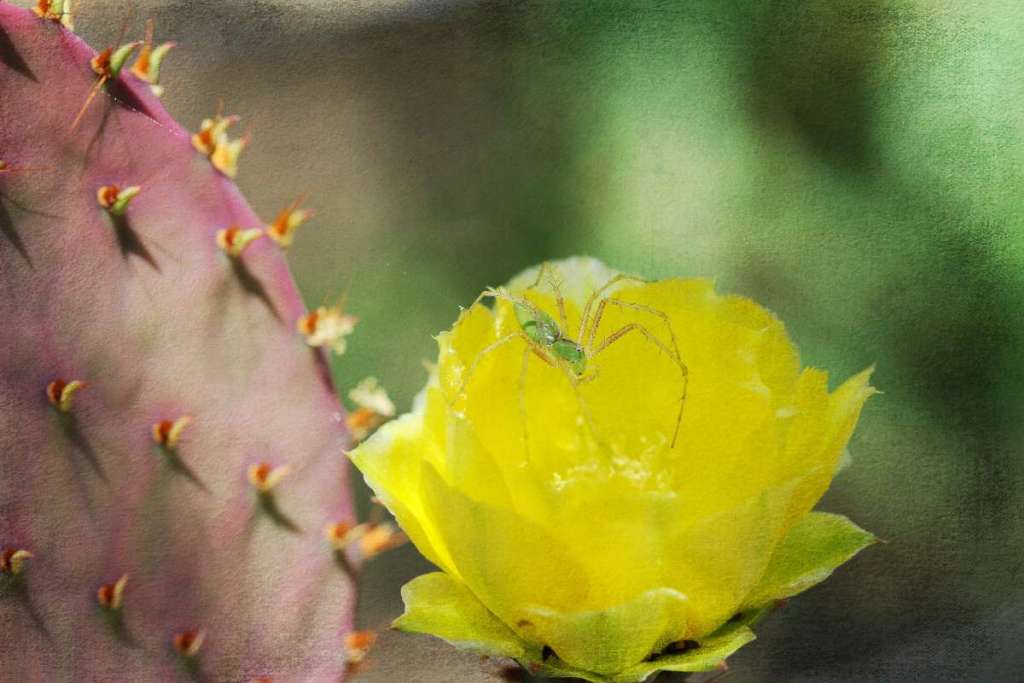
Pollinators and Pests Welcome
“A Green Lynx Spider positions itself on the flower of a prickly pear waiting for prey to arrive. While they do prey on beneficial pollinators, these spiders also
More
eat pest insects and their larvae that could damage the cactus.”
[expand title=”MORE ARTISTS” rel=”fiction”]
Nancy Chilton
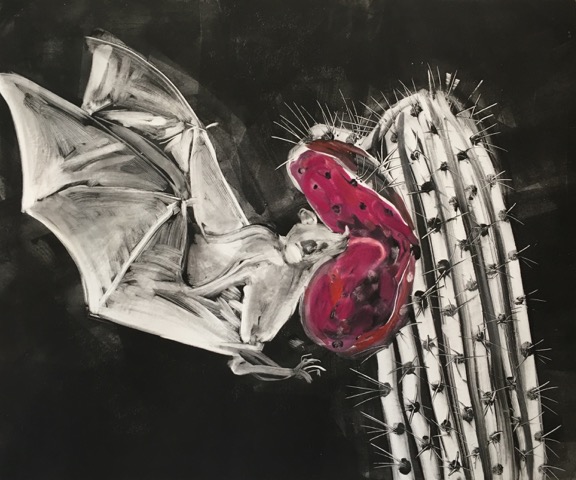
Nectar Buena

Nectar Buena
“These monotypes were inspired in large part by Theodore H. Fleming’s No Species Is an Island, a study of the pollination biology of three species of columnar cacti at a site in Sonora, Mexico, near Kino Bay. What captivated me in particular were the relationships between these cacti and the lesser long-nosed bats (Leptonycteris
More
yerbabuenae), who feed on the nectar, pollen, and fruit of these and other desert plants (including legumes and agaves) during migration. I was not as familiar with this species as I was with its insect-eating relatives, and found myself smitten by these charming, graceful, and athletic bats.
Lesser long-nosed bats join other species of pollinators, including hummingbirds and insects, along routes that Fleming calls ‘nectar corridors’ – seasonal routes defined by a sequence of plants that bloom along a south-to-north gradient in the spring, then reverse in the fall.
Federally listed for protection in the U.S. and Mexico, lesser long-nosed bats are crucial players in a constellation of symbiotic interconnections. These interconnections allow unique and diverse ecosystems to evolve and flourish over long distances.”
to learn more about Nancy Chilton go to: https://thedrawingstudiotds.org/faculty/nancy-chilton/
Pat Frederick
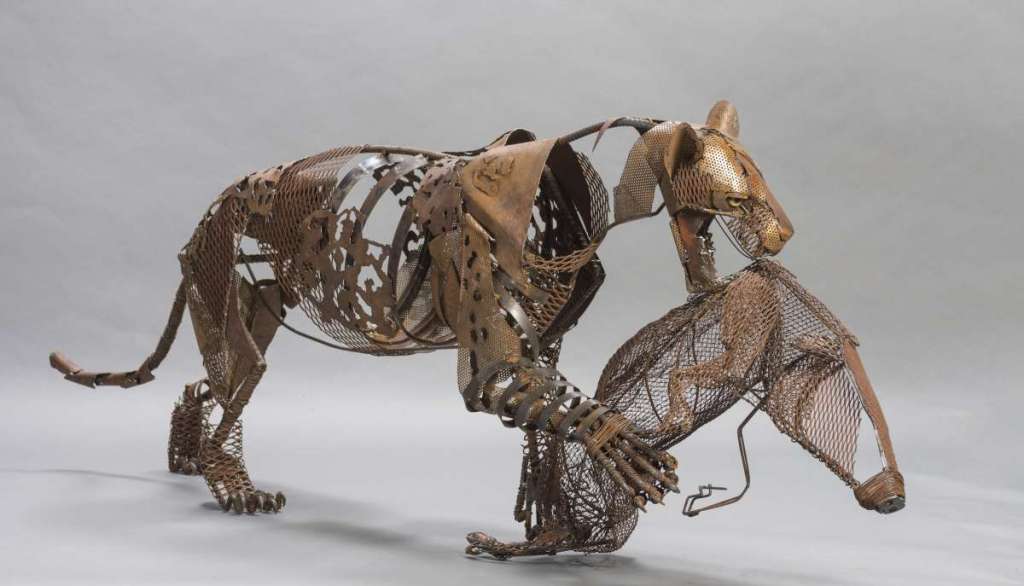
Corazon
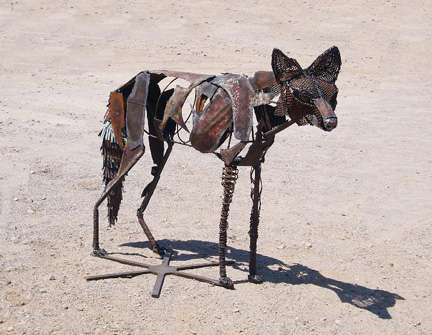
Watching
“There is delight in making a sculpture that represents a very endangered animal. The jaguar is seldom seen because these cats are secretive and rare. I feel sharing the image is important for all of us. Many times the elusive is forgotten. We have been gifted in the last three years with three wandering males found with motion cameras in Southern Arizona.
More
Because I represent Sky Island Alliance as a member and myself as an artist, the word corridor is synonymous with pathway to me.
We save lives of humans and animals with overpasses and underpasses for animals and cars all over the planet. Our involvement with nature benefits us in many ways.
We help animals and people achieve avoidance, safety, and continued existence by developing pathways around and through human development. Continued existence is vital to all as we work in communal ways for all corridors, especially our desert.”
to learn more about Pat Frederick go to: http://patfrederick.com/
Tom Baumgartner
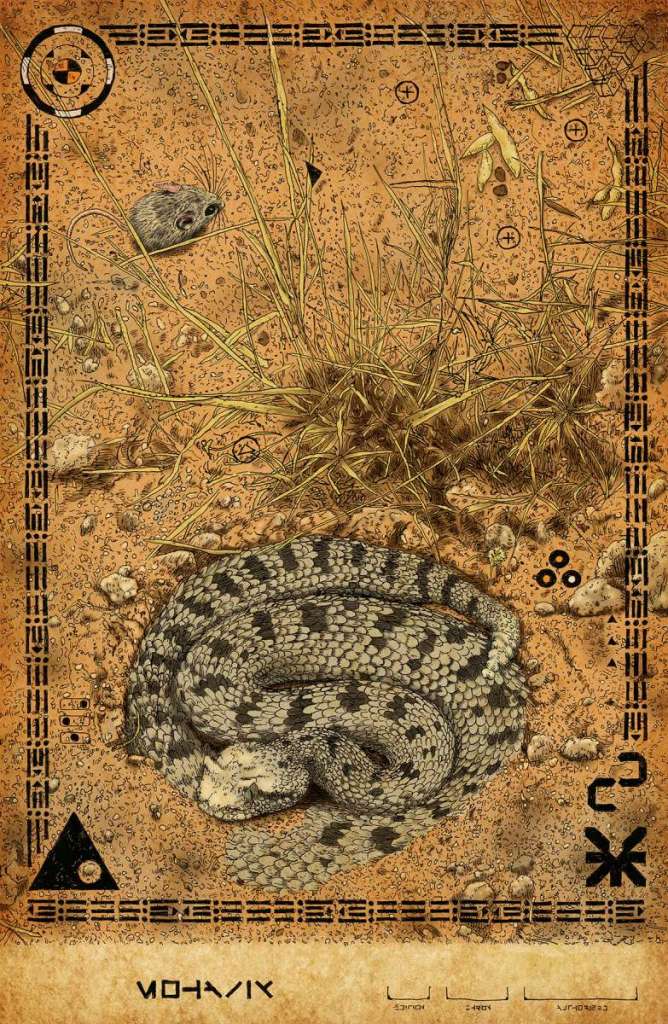
Mohavix
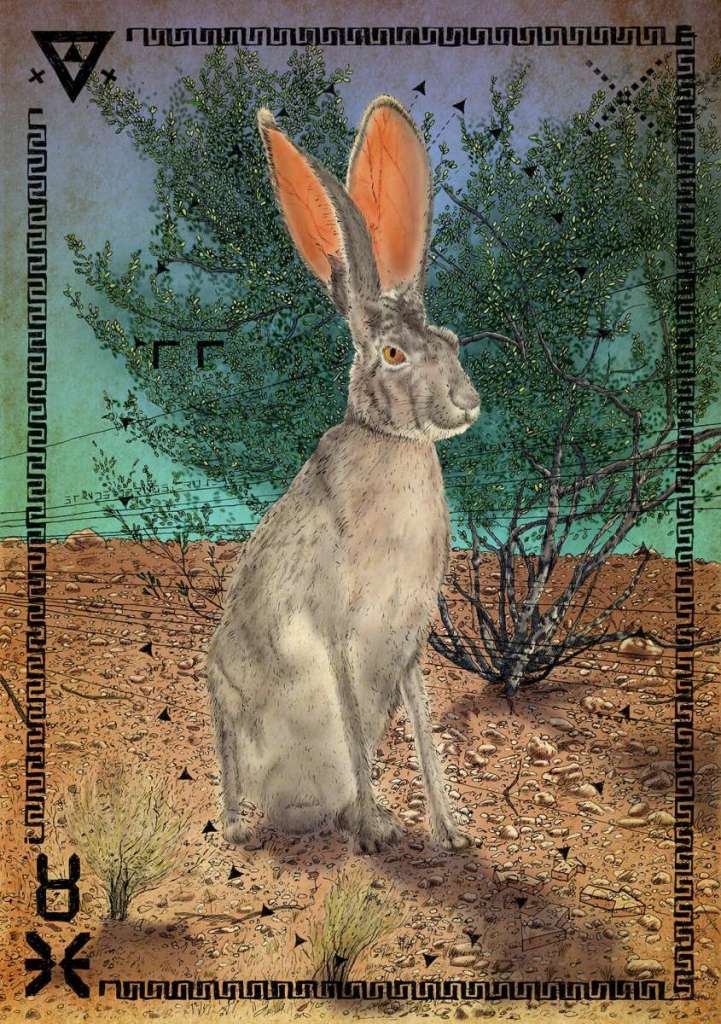
Lepus Allenix
“Beyond symbiosis is the interconnectedness of an entire ecosystem. With this piece I was thinking about margins. Margins of safety, territory, food source, pathways and shelter. I imagine these invisible zones growing and shrinking from minute to minute as creatures hunt, forage, pollinate, burrow, and disperse seeds. The overlay frame is made of word processor icons: center, list and margin.”
More
“Meeting an antelope hare is like meeting a humble ambassador of the desert in its perfectly-to-scale creosote forest. There is something mysterious about the rabbits and hares. Not as much a sense of distrust, but an inner alert and meditative wisdom. I was thinking about this stately way of being near the bottom of the food chain, its strategy of multiple escape plans and zigzag getaway move.”
to learn more about Tom Baumgartner go to: http://patterntology.com/
Rebecca Bish
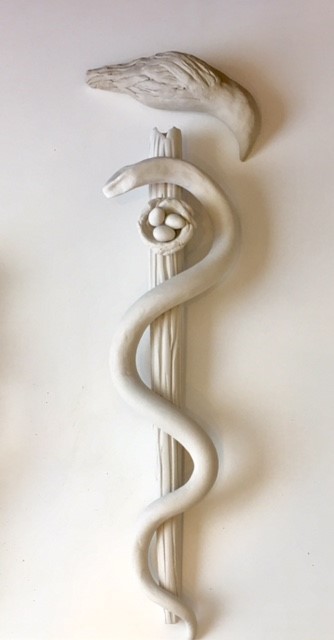
Uneasy Alliance
“In thinking about the concept of symbiosis, I’m struck by the enormous complexity of nature and how it often defies easy
More
categorization. After a long history of scientific debate, symbiotic relationships have generally come to be classified in one of three ways – mutualistic (both organisms benefit), communalistic (one organism benefits, the other is unharmed), and parasitic (one organism benefits, the other is harmed). Uneasy Alliance illustrates the idea that these three well-defined categories of interrelationship may tell only part of the story. In this sculptural clay piece, I’ve depicted two species in which the roles of predator and prey are interchangeable, underscoring the sense of complexity and ambiguity that I often observe in the natural world.”
Brian Hooker
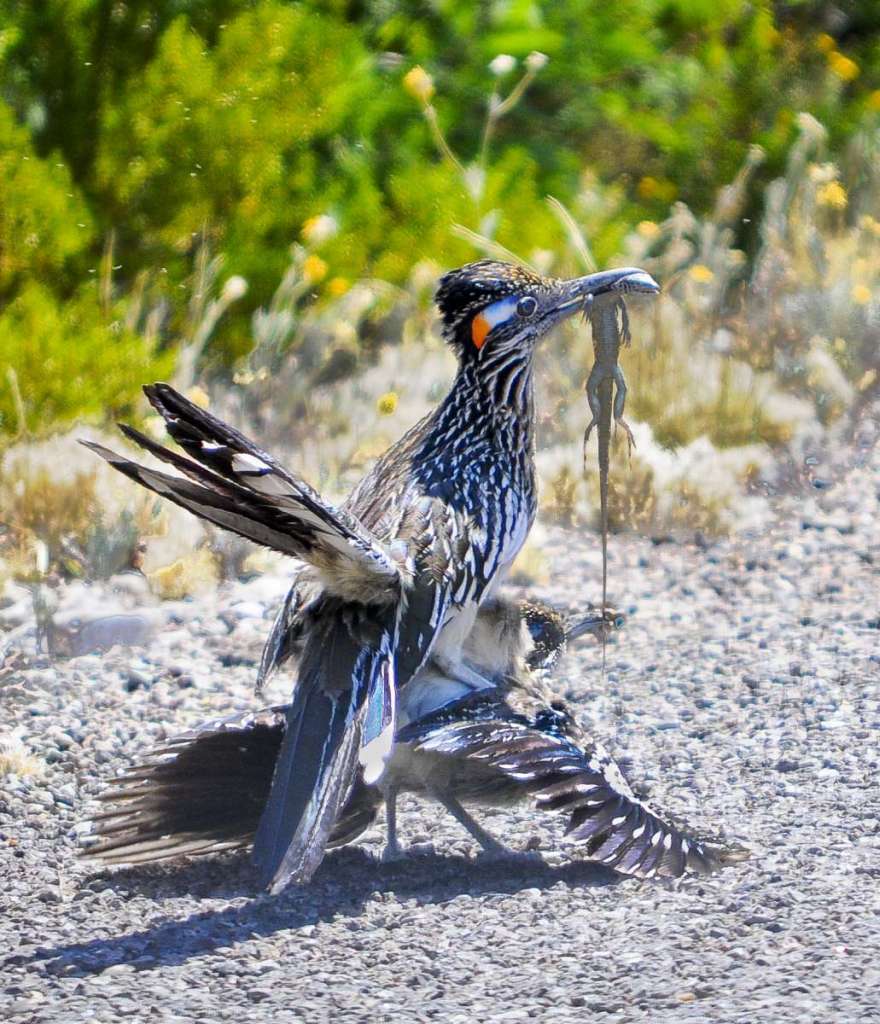
Lunch Date
“A lizard plays a key role in the mating ritual of the Roadrunner. The male Roadrunner offers the tasty lizard to his prospective mate, who keeps her eye
More
on the prize until mating is completed. She then snatches the lizard and disappears into the brush. It is unlikely the lizard appreciates its importance in the reproductive behavior of Roadrunners.”
to learn more about Brian Hooker go to: https://brianhooker.zenfolio.com/
Victoria von Elbe
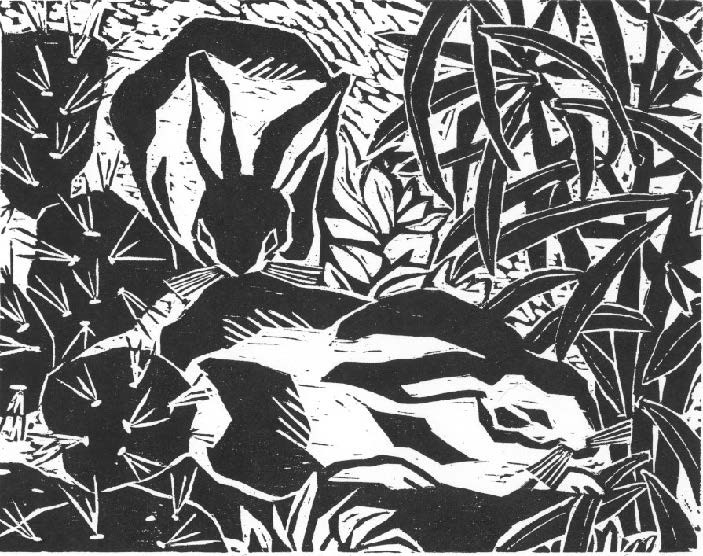
Rabbits Resting
“Animals and plants benefit thru feeding relationships. As I observe in my backyard: Rabbits nibbling on prickly pear pads and fruit, then dispersing seeds thru scat that produces a new plant.”
Michael Mason
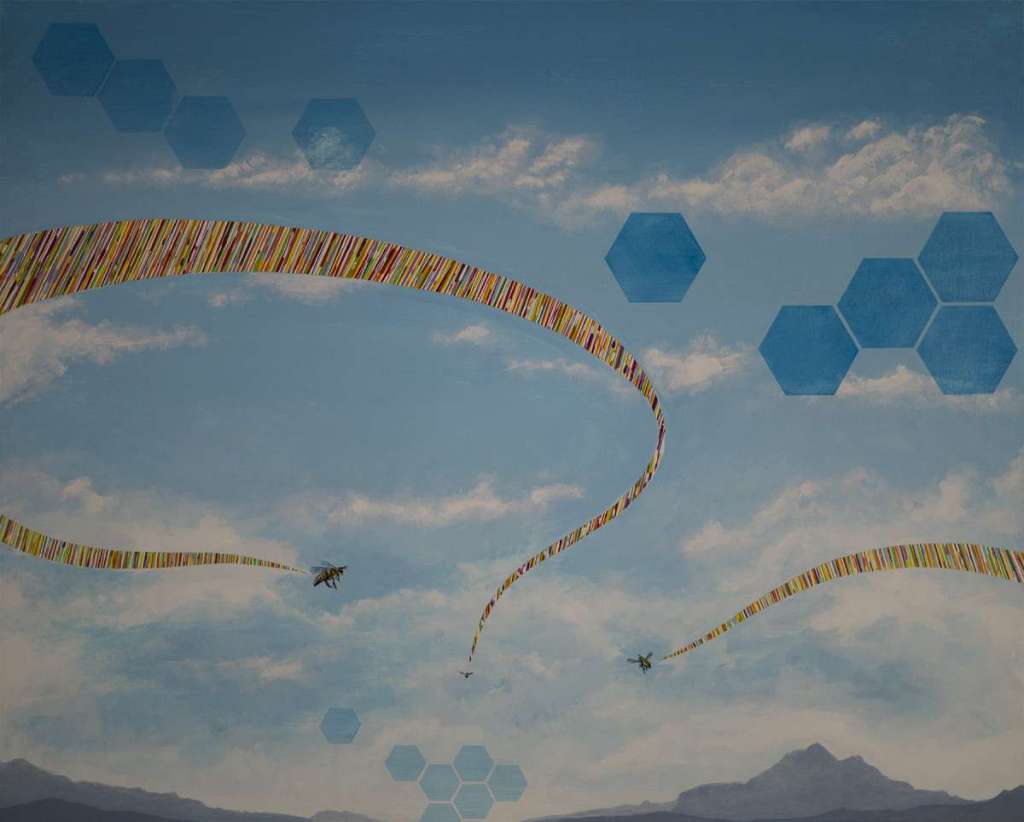
Sonoran Keystone
“Bees play a vital role in the perpetuation of life within the Sonoran Desert bioregion. Their work as pollinators ensures a new generation of plants and seasonal fruits, many of which are consumed by native wildlife
More
as well as humans. Bees pollinate roughly 80% of the flora in the Sonoran Desert. Without bees, many native plant species would disappear, forever changing the landscape. Bees themselves benefit from the pollen they sew. This protein rich food source nourishes bees and their larva, and the sweet nectar they consume provides them with a quick boost of energy. Much of a bee’s activity goes unnoticed. They selflessly go about their business without adulation or fanfare. In Sonoran Keystone, I imagine bees that are much more noticeable. Bees that leave a contrail of colorful pollen as they fly through our desert sky illuminating the vital work they perform to sustain our ecosystem.”
to learn more about Michael B. Mason go to: http://www.michaelbmason.com/
Kimberly Kanoa Duffek
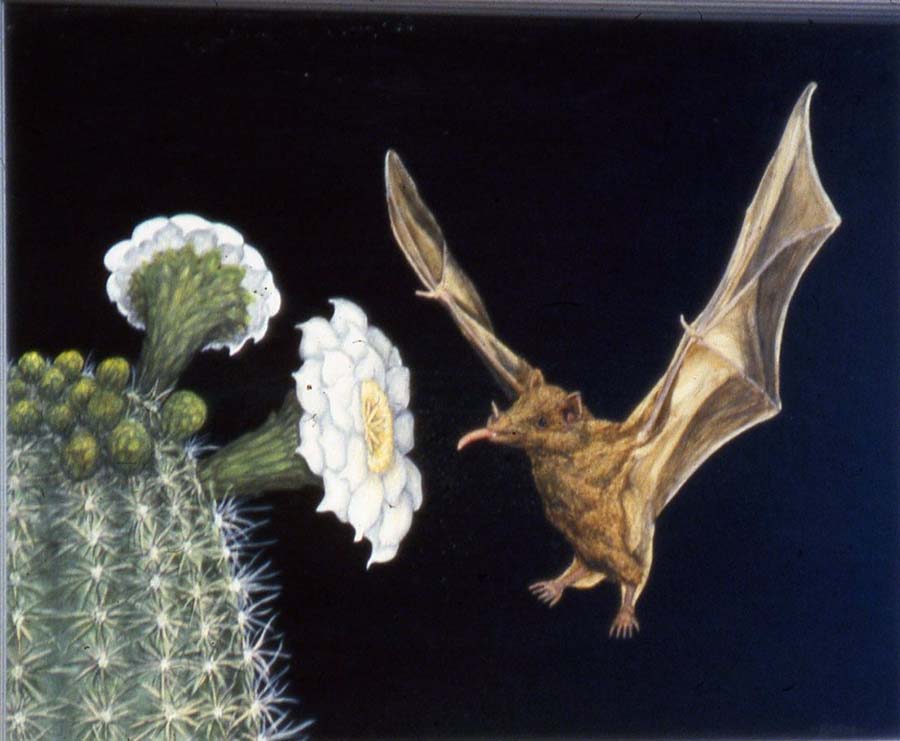
Interdependence
“Like most dwellers of the Sonoran Desert, I have a special affinity for the saguaro cactus. In this classic example of mutualism, the endangered Lesser Long Nose bat needs to feed on the nectar from the Arizona state flower,
More
the saguaro blossom and the saguaro needs the bat to cross pollinate its flowers. This painting beautifully captures the action as the bat prepares to feed.”
to learn more about Kimberly Kanoa Duffek go to: http://www.artistsforconservation.org/programs/awards/monthly-conservation-artist/2015/kim-duffek
[/expand]
Recommendations
Read
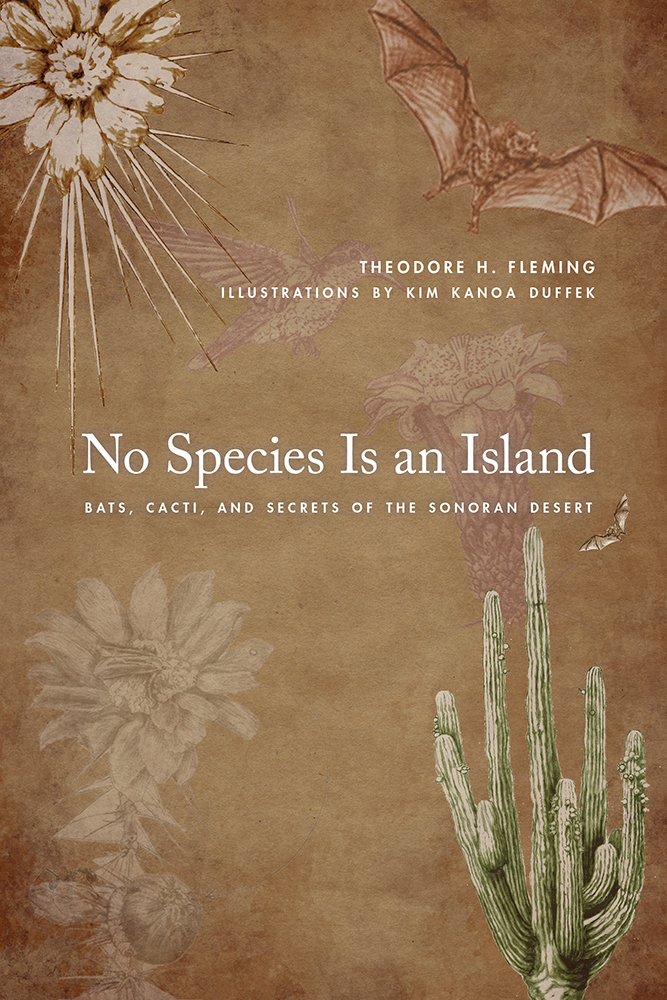
In the darkness of the star-studded desert, bats and moths feed on the nectar of night-blooming cactus flowers. By day, birds and bees do the same, taking to blooms for their sweet sustenance. In return these special creatures pollinate the equally intriguing
More
plants in an ecological circle of sustainability.
“No Species Is an Island is about the most important story on Earth: the astonishing interconnections that keep the living world alive. It reads like what it is: a beautifully illustrated detective story into the real world, in a particularly magical land of shadows where all the plants keep secrets and all the animals harbor hard-held mysteries. Dive in and savor.”—Carl Safina, author of Beyond Words
Art
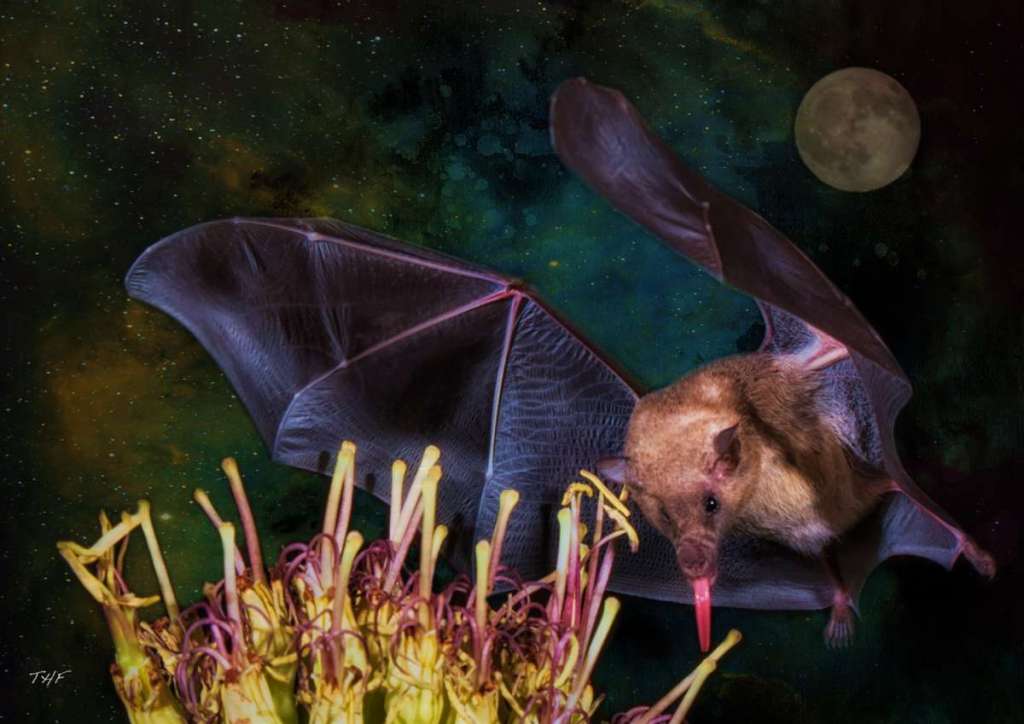
Most Sonoran Desert plants rely on animals to move their pollen from one to another. And most of these pollinators are small, low energy-demanding insects; but there are notable exceptions to this. Columnar cacti and paniculate agaves, for example, rely strongly on relatively large, energy-demanding hummingbirds and nectar-feeding bats as their major pollinators. This image shows a nectar-feeding bat, Leptonycteris yerbabuenae, visiting the inflorescence of the century plant, Agave palmeri, for a tongueful of nectar. It will repeatedly visit these and other agave flowers each night and will sometimes carry pollen several kilometers between plants.

“I took this photograph of a female Greater Roadrunner (Geococcyx californianus) with a Zebra-tailed Lizard in its mouth on the north desert trail at Tohono Chul Park. A pair of these birds nests in this area. Roadrunners are iconic birds of the Sonoran Desert and other arid habitats in the U.S. Southwest and northern Mexico. Members of the cuckoo family (Cuculidae), roadrunners are voracious predators and include lizards, snakes (including small
More
rattlesnakes), baby and adult birds, and small mammals in their diet. They can fly but spend most of the time on the ground; they can run up to 20 miles per hour.”
Watch
Dr. Fleming talks about the novel discoveries that he and his research team made during an 11-year study of the pollination biology of four species of Sonoran Desert columnar cacti. These discoveries are described in the book, “No Species is an Island: Bats, Cacti, and Sonoran Desert Secrets” recently published by the University of Arizona Press. They include the odd breeding system of the cardon cactus; the highly specialized pollination system of the senita cactus; and the amazing life-history of the nectar feeding bat, Leptonycteris yerbabuenae, an important pollinator of cardon, saguaro, and organ pipe cacti. The book’s illustrator, Kim Kanoa Duffek, and Dr. Fleming also discuss how they came to collaborate on this book.
to learn more about Ted Fleming go to: https://www.tedflemingphotography.com/
Day 5 – Weekend Inspiration
Practice What You’ve Learned
Activity Cards
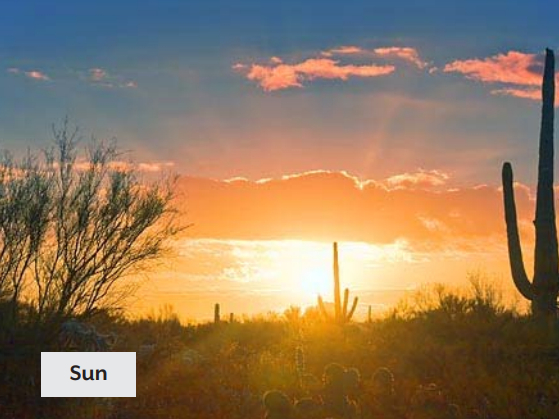
Who Eats Whom
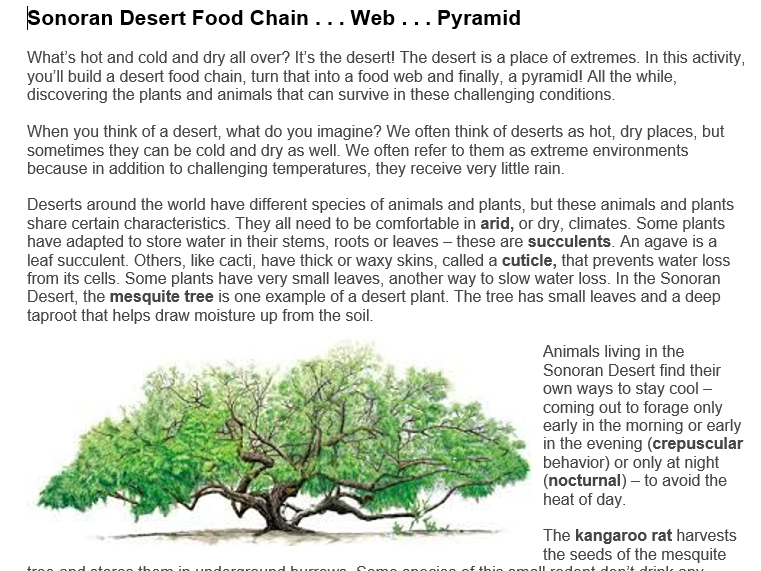
Make A Food Chain
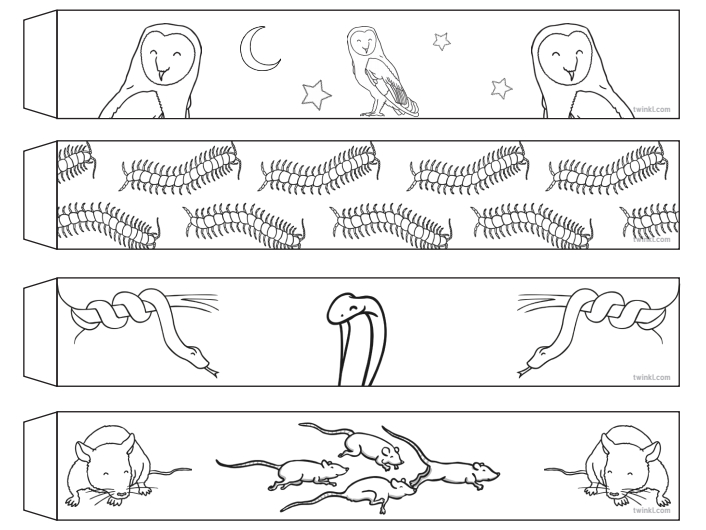
Web of Life
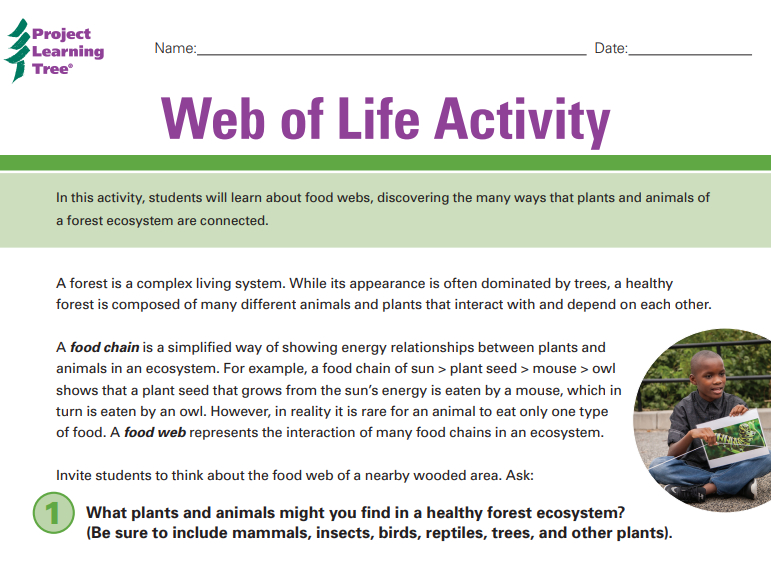
Next Week’s Theme
